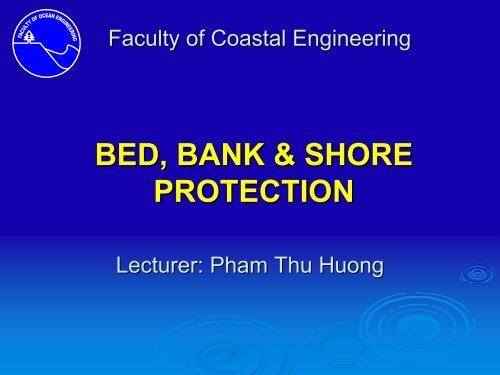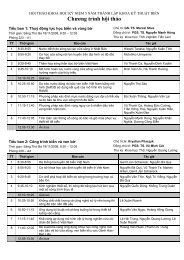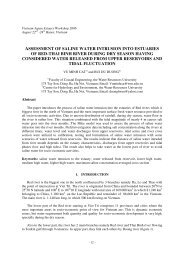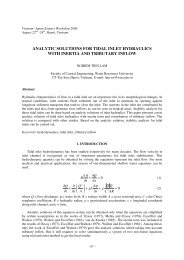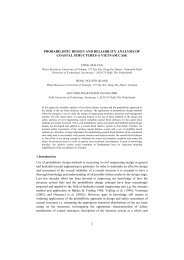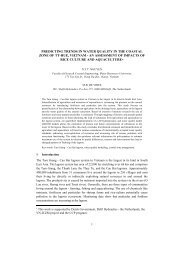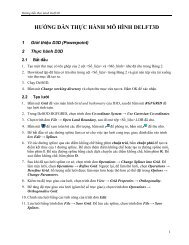BED, BANK & SHORE PROTECTION
BED, BANK & SHORE PROTECTION
BED, BANK & SHORE PROTECTION
You also want an ePaper? Increase the reach of your titles
YUMPU automatically turns print PDFs into web optimized ePapers that Google loves.
Faculty of Coastal Engineering<br />
<strong>BED</strong>, <strong>BANK</strong> & <strong>SHORE</strong><br />
<strong>PROTECTION</strong><br />
Lecturer: Pham Thu Huong
Chapter 6<br />
Waves - Loads<br />
(6 class hours)
6.1 Introduction<br />
Content<br />
6.2 Non breaking waves<br />
6.3 Breaking waves<br />
6.4 Wave on the slope<br />
6.4 Reduction of wave loads<br />
6.5 Summary
Wave issues<br />
Generation: H, T characteristic = f (u wind, h, fetch)<br />
Hydrodynamics: u, p, τ = f (H,T,h)<br />
Statistics:p(H) = f (H characteristic, distribution function)<br />
3. Wave statistics<br />
1. Wave generation<br />
2. Wave hydrodynamics
Examples of wave loads<br />
In which:<br />
(A) - standing wave<br />
(B) - breaking wave on a mild slope<br />
(C) - breaking wave on a steeper slope
Wave motion in periodic,<br />
unbroken wave
Validity of wave theories
Application of linear theory
gradient in filter under breakwater
Friction under waves
with:<br />
friction factor and cf uˆ= ω a =<br />
b b<br />
u = uˆbsinω t<br />
1 c u<br />
2<br />
w 2 f b<br />
ˆ ˆ<br />
τ = ρ<br />
ω a<br />
sinh kh<br />
( ) 0.19 −<br />
a k<br />
⎡<br />
⎢<br />
− 6.0+ 5.2<br />
⎣ b/ r<br />
⎤<br />
⎥⎦<br />
f f max<br />
a b: wave amplitude at<br />
bottom<br />
ω : angular frequency<br />
in waves (=2π/T)<br />
c = e with: c = 0.3
Shoaling<br />
Near-shore Near shore effects
Shoaling<br />
Refraction<br />
Near-shore Near shore effects
Shoaling<br />
Refraction<br />
Diffraction<br />
Near-shore Near shore effects
Shoaling<br />
Refraction<br />
Diffraction<br />
Reflection<br />
Near-shore Near shore effects
Shoaling<br />
Refraction<br />
Diffraction<br />
Reflection<br />
Breaking<br />
Near-shore Near shore effects
eaking waves<br />
⎛2π⎞ H = 0.142 L tanh h<br />
b<br />
⎜ ⎟<br />
⎝ L ⎠<br />
Hb<br />
0.78 ( solitary wave)<br />
h ≈<br />
H<br />
h<br />
s<br />
≈0.4 −0.5
the Iribarren number<br />
(surf similarity parameter)<br />
ξ =<br />
tan<br />
α<br />
H L<br />
tan α slope of the shoreline/structure<br />
H wave height<br />
L0 wave length at deep water<br />
0
eaker types
eaker types<br />
spilling ξ < 0.5<br />
plunging 0.5 < ξ < 3<br />
collapsing ξ = 3<br />
surging ξ > 3<br />
(sóng vỗ bờ)<br />
(Sóng cuộn đổ)<br />
(sóng đổ)<br />
(sóng cồn,<br />
sóng dâng)
ore and hydraulic jump
H R 2<br />
Kr = ≈0.1ξ<br />
H<br />
I<br />
reflection<br />
Battjes, 1974<br />
small ξ less reflection<br />
K r = 1 seawall (standing wave)
Loads due to breaking
Breaker-depth<br />
Breaker depth<br />
γ b = H/h = 0.78 (solitary wave limit)<br />
γ b = 0.88 (Miche formula)
change of distribution in<br />
shallow water
un up
Run-up Run up calculation<br />
Hunt’s Formula (for regular waves)<br />
Ru<br />
H ξ =<br />
CUR/TAW, 1992 (for Irregular waves)<br />
R = 1.5 γ γ γ γ H ξ ( R = 3 H )<br />
u2% r β B f s p u 2% max s<br />
correction factors:<br />
• γr roughness<br />
• γβ approach angle<br />
• γB berm reduction<br />
• γf foreshore reduction
Wave run-up run up irregular wave<br />
H s = significant wave height<br />
ξ 0 = breaker parameter based on T m-1,0<br />
For smooth slope
γr 1.0<br />
friction values<br />
Type of revetment<br />
Asphalt, concrete, smooth blocks, grass,<br />
Sand-asphalt<br />
Sand asphalt<br />
0.95 Blocks in asphalt or concrete matrix,<br />
blocks with grass<br />
0.90 Placed block revetment<br />
0.80 riprap penetrated with asphalt<br />
0.70 Single layer of riprap<br />
0.55 Double layer of riprap
Angle of attack<br />
For long crested waves (swell)<br />
γγ ββ = √cos cos ββ<br />
(with minimum of 0.7)<br />
For short crested waves (wind wave)<br />
γγ ββ = 1 - 0.0022 (ββ in degrees)<br />
(with with a minimum of 0.8)
SWL<br />
H s<br />
γ<br />
B<br />
berm effect<br />
h B<br />
B B<br />
L B<br />
2<br />
⎛ ⎡ ⎤ ⎞<br />
B B<br />
B h<br />
= 1− ⎜1−0.5 ⎟<br />
L ⎜<br />
⎢ ⎥<br />
B H ⎟<br />
⎝ ⎣ s⎦⎠<br />
limits: 0.6 < γ B < 1 and -1 < d h /H s < 1<br />
H s
Shallow foreshore<br />
γ f = H 2% / 1.4H s
Battjes formula, 1994:<br />
R = R 1− 0.4ξ=<br />
d u<br />
( )<br />
= H 1−0.4ξ ξ<br />
( )<br />
run-down run down<br />
R = −0.33<br />
H ξ<br />
d 2%<br />
s p<br />
( R =−1.5<br />
H )<br />
d 2% max<br />
s
Example<br />
A dike with concrete block revetment, slopes 1:3 and a<br />
2 m berm at design level is attacked by perpendicular<br />
(swell) waves with Hs = 1 m and a steepness of 0.01.<br />
What is the wave run-up? run up?<br />
H S = 1<br />
Wave Slope = 0.01<br />
1:3 Ru ?<br />
1:3<br />
2m
γ<br />
B<br />
2<br />
⎛ ⎡ ⎤ ⎞<br />
B B<br />
B h<br />
= 1− ⎜1−0.5 ⎟<br />
L ⎜<br />
⎢ ⎥<br />
B H ⎟<br />
⎝ ⎣ s⎦⎠<br />
solution<br />
Starting point is equation for run-up run up irregular wave R u2%. u2% .<br />
R = 1.5 γ γ γ γ H ξ ( R = 3 H )<br />
u2% r β B f s p u 2% max s<br />
γγ r = 0.9<br />
γγ ββ = 1 and γγ f = 1<br />
hB = 0<br />
LB = 2Hs 2Hscot<br />
cotαα + 2 = 8 m<br />
hence, γγ B = 0.75<br />
The surf similarity parameter is tanαα/0.1 tan /0.1 = 3.33 > 2, hence ξ = 2. 2.<br />
The wave run-up, run up, finally, is then: Ru2% u2% = 1.5*0.9*0.75*1*2 ≅ 2m<br />
above the design level.
Samphire Hoe,<br />
United Kingdom<br />
overtopping<br />
Ostia, Italy
Overtoping in Jaade Siel, Germany<br />
22-12-1954
Measured overtopping (breaking)
Measured overtopping<br />
(non-breaking)<br />
(non breaking)
Seaward slope seadike Haiphong
Sea dike near Haiphong
After Durian (2005)
TAW formula, 2000:<br />
wave impacts on slope<br />
pmax 50% ≈ 8ρw gHs<br />
tanα<br />
pmax 0.1% ≈16<br />
ρw gHs<br />
tanα
Waves<br />
Load reduction<br />
transmission<br />
Coastal line<br />
reflection<br />
absorption<br />
Costs Effectiveness
Linear wave theory
definitions and behaviour of<br />
hyperbolic functions
standing wave
Relative depth<br />
Wave Celerity<br />
Wave Length<br />
Group<br />
Shallow Water<br />
h 1<br />
<<br />
L 20<br />
c =<br />
L<br />
= gh<br />
c =<br />
L<br />
=<br />
T<br />
T<br />
L = T g h<br />
Velocity c = c = g h<br />
g<br />
Energy Flux<br />
1<br />
2<br />
(per m width) F = E c = ga g h<br />
Particle<br />
velocity<br />
Horizontal<br />
Vertical<br />
Particle<br />
displacement<br />
Horizontal<br />
Vertical<br />
Subsurface<br />
pressure<br />
g<br />
Transitional water depth<br />
L<br />
=<br />
1 h 1<br />
< <<br />
20<br />
L<br />
2<br />
Deep Water<br />
h 1<br />
><br />
gT<br />
L<br />
tanh kh<br />
c = c = =<br />
0<br />
2 π<br />
T<br />
2<br />
gT<br />
gT<br />
tanh kh<br />
L = L =<br />
0<br />
2 π<br />
2 π<br />
L<br />
NM<br />
O<br />
QP<br />
1 2 kh<br />
c<br />
g<br />
= n c =<br />
2<br />
1 +<br />
sinh 2 kh<br />
∗ c<br />
L<br />
2<br />
gT<br />
2 π<br />
1 gT<br />
c<br />
g<br />
= c<br />
0<br />
2<br />
=<br />
4 π<br />
1<br />
T<br />
2<br />
ρ F = E c = ρ ga n c<br />
F = ρ g a<br />
g<br />
2<br />
2<br />
8 π<br />
u = a<br />
g<br />
h<br />
sin θ<br />
e j cos<br />
z<br />
w = ω a 1 + θ<br />
h<br />
a g<br />
ξ = − cos θ<br />
ω h<br />
( )<br />
cosh k h + z<br />
u = ω a<br />
sin θ<br />
sinh kh<br />
( )<br />
sinh k h + z<br />
w = ω a<br />
cos θ<br />
sinh kh<br />
( )<br />
cosh k h + z<br />
ξ = − a<br />
cos θ<br />
sinh kh<br />
( )<br />
sinh k h + z<br />
ζ = a<br />
sin θ<br />
sinh kh<br />
( )<br />
cosh k h + z<br />
p = − ρ g z + ρ g a sin θ<br />
p = − ρ g z + ρ g a<br />
cosh kh<br />
sin θ<br />
a<br />
H<br />
2 π 2 π<br />
= ω = k = θ = ω t − k x<br />
2<br />
T<br />
L<br />
2<br />
2 2<br />
u a e kz<br />
= ω sin θ<br />
w a e kz<br />
= ω sin θ<br />
ξ = − ae θ<br />
kz<br />
cos<br />
ζ = ae θ<br />
kz<br />
sin<br />
p g z g a e kz<br />
= − ρ + ρ sin θ<br />
linear wave<br />
theory<br />
basic equations
parameters<br />
in linear<br />
wave theory
definition of H and T
wave definitions and wave height<br />
distribution
Rayleigh distribution<br />
2 2<br />
⎡ ⎤ ⎡ ⎤<br />
⎛ H ⎞ ⎛ H ⎞<br />
P{ H > H}<br />
= exp ⎢− ⎜ ⎟ ⎥ = exp ⎢−2⎜ ⎟ ⎥<br />
⎢ Hrms H<br />
⎣ ⎝ ⎠ ⎥⎦ ⎢⎣ ⎝ s ⎠ ⎥⎦<br />
H ≡ H ≡ H ≡ H ≡ H ≈4m<br />
s visual 1/3 13.5% m0<br />
0
wave height and wave period
wave registration in the North Sea<br />
Spectral moments: m 0 = surface of energy density spectrum<br />
m -1 = first negative moment of spectrum<br />
T m-1,0 = m -1 /m 0 = spectral wave period ≈ 0.9
spectrum types
two types of spectra
wave spectra across shallow bar
wave generation<br />
Deep water (no limitations of depth and fetch):<br />
gH s gTs<br />
= 0.283 and = 1.2<br />
2<br />
u 2π<br />
u<br />
w w<br />
Shallow water (limitations of depth and fetch) :<br />
⎡ 0.42 ⎤<br />
⎢ ⎛ gF ⎞<br />
0.75 0.0125<br />
⎥<br />
2<br />
gH ⎡ ⎜ ⎟<br />
⎛ s<br />
gh ⎞ ⎤ ⎢ u ⎥<br />
w<br />
= 0.283tanh ⎢0.578 tanh<br />
⎝ ⎠<br />
2 ⎜ 2 ⎟ ⎥ ⎢ ⎥<br />
0.75<br />
uw u ⎡ w<br />
gh ⎤<br />
⎣<br />
⎢ ⎝ ⎠ ⎦<br />
⎥ ⎢ ⎛ ⎞ ⎥<br />
⎢tanh ⎢0.578⎜ ⎥ 2 ⎟ ⎥<br />
⎢ ⎢ uw<br />
⎥<br />
⎣ ⎣ ⎝ ⎠ ⎦ ⎥⎦<br />
⎡ 0.25 ⎤<br />
⎢ ⎛ gF ⎞<br />
0.375 0.077<br />
⎥<br />
2<br />
gT ⎡ ⎜ ⎟<br />
⎛ s<br />
gh ⎞ ⎤ ⎢ u ⎥<br />
w<br />
= 1.20 tanh ⎢0.833 tanh<br />
⎝ ⎠<br />
⎜ 2 ⎟ ⎥ ⎢ ⎥<br />
0.375<br />
2π<br />
uw ⎢ u<br />
⎣ ⎝ w ⎠ ⎥<br />
⎦<br />
⎢ ⎡ ⎛ gh ⎞ ⎤ ⎥<br />
⎢tanh ⎢0.833⎜ ⎥ 2 ⎟ ⎥<br />
⎢ ⎢ uw<br />
⎥<br />
⎣ ⎣ ⎝ ⎠ ⎦ ⎥⎦
wave height as function of wind,<br />
depth and fetch
wave period as function of wind,<br />
depth and fetch


